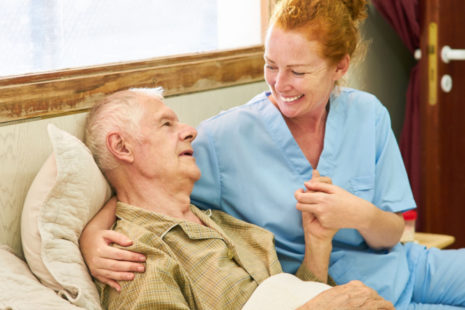Paralysis involves losing the ability to move body parts due to the loss of muscle function in that part of the body.
Paralysis can affect one or both sides of the person’s body. It can be partial or complete, temporary or permanent.
Paraplegia involves loss of use of the legs and loss of feeling in the legs (although the legs remain perfectly healthy) because the brain and the spinal cord cannot send and receive the signals to the lower body.
This causes the inability to voluntarily move the lower parts of the body, which is why most paralyzed persons need 24/7 care.
How Do You Care for a Paralyzed Person at Home?
Caregiving for a paralyzed person at home can help your family member live a healthier and more independent life. In addition, it can help a paralyzed person feel more connected and supported.
While being a caregiver for a loved one can be a gratifying experience, it can also be challenging. As a result, you may feel overwhelmed and scared. However, getting informed and learning some essential caregiving skills can help you provide helpful and safe caregiving to your loved one at home.
Firstly, familiarize yourself with your daily tasks and activities as a caregiver for a paralyzed person at home. Next, learn about the paralysis’ implications on your loved one’s other bodily functions and mental health. Finally, learn about emotional support resources available for caregivers to reduce stress and prevent caregiver burnout.
Daily Activities when You Care for a Paralyzed Person at Home
Every person is unique, so it is every paralysis. Therefore, there is no unique strategy to follow when caring for a paralyzed person at home.
However, if you are a caregiver for a loved one with paralysis or paraplegia, seek advice from qualified professionals about the best way to provide care for a loved one.
Some of the typical caregiving activities you will perform when caring for a paralyzed person at home involve:
- assisting with the person’s activities of daily living (ADLs)
- changing position to avoid bed sores and other secondary potentially dangerous conditions exercise
- taking care of the person’s emotional needs
Activities of Daily Living for a Paralyzed Person at Home
People with paralysis or paraplegia experience difficulties in daily living that restrict their ability to perform self-care and other everyday activities essential for maintaining an independent life.
ADLs your loved one might struggle with include:
- Dressing
- Eating
- Bathing
- Grooming
- Moving
- Getting in and out of bed
- Toileting
- Cooking
- Cleaning
- Shopping
- Doing the laundry
- Using the telephone
- Handling money
- Driving
- Using public transport
Preventing Pressure Sores for a Paralyzed Person at Home
A bedridden paralyzed person needs to change position throughout the day to avoid harmful secondary conditions such as bedsores, blood clots, or other injuries.
Pressure sores, also known as pressure ulcers or bedsores are very common among bedridden persons. They occur due to constant pressure and moisture as a result of the inability to move and change position.
To prevent pressure sores, make sure not to leave a loved one in the same position for a prolonged time. Regular position change and passive exercises can help along with healthy nutrition and quick change of the wet or dirty dressing, clothing, and bedding.
Exercise for a Paralyzed Person at Home
Physical therapy and exercise are essential parts of your loved one’s daily routine, helping maintain physical and emotional well-being. Exercise can help your loved one stay stronger both physically and mentally.
How Do You Care for a Paralyzed Person?
The first step in your care for a paralyzed person is to understand the paralysis – how it affects your loved one and the treatments and care they need.
In addition to preventing bedsores and assisting the person with their activities of daily living, make sure to encourage your loved one to keep on with their life. Please enable them to socialize, engage in hobbies, exercise, and accomplish their goals.
Emotional Care for a Paralyzed Person at Home
Your loved one’s emotional and mental health is just as important as their physical health. one of the best ways to help a loved one is to encourage them to stay active, connected, and engaged.
Sudden mood swings, anxiety, and depression are prevalent in paralyzed persons. So, make sure to recognize red flags such as negative thoughts, withdrawal, loss of interest in everyday activities, sleep problems, etc.
You can do things to help your loved one combat the emotional distress linked to paralysis. Firstly, encourage the person to talk about their feelings. Help them stay connected and socialize with family and friends. Encourage your loved one to engage in hobbies and participate in community life. Help them seek professional mental health support and encourage them to join a spinal cord injury support group. Talking to other people with paralysis can help you learn to live with your condition.
Can a Paraplegic Live at Home?
Yes, they can. However, paraplegia is a life-changing condition. Suppose your family member with paraplegia wants to live at home. In that case, you need to make some adaptions in your home and ensure that the person receives the necessary care.
Learning how to adapt to a new life with paraplegia is important for the person with paraplegia and their family members. Not being able to move the lower part of the body, stand up, and walk can cause various additional conditions ranging from mild to life-threatening.
Some of the most common complications linked to paraplegia involve bedsores, urinary tract infections, circulatory disorders, and mental health disorders such as depression.
It is important to help your loved one with exercises and position change a couple of times throughout the day to prevent pressure sores. Also, regular exercise and occupational therapy can prevent circulatory disease.
Help your loved one learn to take care of their bladder to prevent urinary tract infections. Encourage them to work with their doctor and other health professionals to develop bowel management that will help regulate the person’s bowel movements.
Encourage your loved ones to express their emotions, grieve, and seek help with coping if they need it.
How Do You Care for Someone with Spinal Cord Injury?
Staying at home means minimum changes in the person’s existing routine or lifestyle. A caregiver needs to ensure that the person with spinal cord injury (SCI) receives necessary care at home.
Investigate your loved one’s recovery and therapy options. Unfortunately, the perfect spinal cord injury therapy does not exist. However, high-quality treatment and care can help prevent injury aggravation, alleviate the side effects of spinal cord injury, help improve your loved one’s quality of life.
Also, make modifications at home, such as installing ramps or wheelchair lifts, widening doorways, etc., to accommodate your loved one’s mobility limitations.
What Happens When Someone Becomes Paralyzed?
Paralysis is the loss of muscle function in one or more parts of the body due to a nervous system injury or disease. Affected nerves cannot send signals to muscles, so people with paralysis cannot move certain parts of their bodies.
Data shows that about one in fifty Americans have some form of paralysis. While some people experience partial or temporary paralysis, permanent paralysis is irreversible, meaning the person never regains muscle control.
The most common causes of paralysis involve:
- Spinal cord injury
- Stroke
- Multiple sclerosis
- Amyotrophic lateral sclerosis
- Cerebral palsy
A spinal cord injury can happen for various reasons. Some of the most common causes involve a car crash, fall, sports injury, or another spinal cord injury that cuts the spinal cord, stopping the communication between the brain and the rest of the body.
A spinal cord injury can cause various types of paralysis, such as:
- Monoplegia – a paralysis that occurs in one arm or leg
- Hemiplegia – a paralysis that affects one arm and one leg on the same side of the body
- Paraplegia – a paralysis that affects both legs
- Quadriplegia – a paralysis that occurs in both arms and both legs
The first thing your loved one needs to do is learn about their condition. Understanding paralysis can help the person accept their changed life circumstances, consider appropriate treatment and care options, and go on with their life.
Psychotherapy can help your loved one cope with a loss of mobility, so support them by looking for a qualified therapist.
Does a Spinal Cord Injury Shorten Your Life?
Research suggests that survival and life expectancy after a spinal cord injury are strongly related to the severity of neurological impairment.
Over the previous decades, life expectancy in the SCI population has increased dramatically, resembling that of the general population.
People with SCI are likely to experience secondary chronic health problems such as pneumonia or urinary tract infections. However, advancements in medicine and technology improved the ability to identify and treat such secondary complications, extending life expectancy after a spinal cord injury.
MRIs and PET scans, medications, and highly qualified medical professionals can help your loved one get through and improve the quality of their life.







